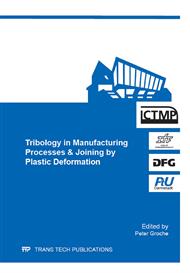p.228
p.242
p.249
p.259
p.270
p.281
p.290
p.301
p.311
Experimental and Numerical Investigations on Frictional Behaviour under Consideration of Varying Tribological Conditions
Abstract:
In present time the FE-simulation of body parts in sheet metal drawing processes has to be continuously improved to increase the prediction accuracy. The objective of this paper is to describe a methodology to improve the simulation by mapping the complex tribological conditions of the process in the simulation. This methodology focuses on the dependency of influencing parameters on the friction coefficient. The influence respectively the dependency of these factors has been investigated, both in an experiment of a plane strip drawing test and in a FE-simulation of this test. With the sensitivity analysis in the numerical simulation it is possible to compare the implemented Coulomb-friction-model against the experimental results. The results of the experimental and numerical investigation show the need of further investigations on a more geometrical complex test to prove if it is possible to transfer the knowledge and dependencies that has been found in the experiment with the strip drawing test to a more geometrical complex test.
Info:
Periodical:
Pages:
270-278
Citation:
Online since:
June 2014
Authors:
Keywords:
Price:
Сopyright:
© 2014 Trans Tech Publications Ltd. All Rights Reserved
Share:
Citation:


